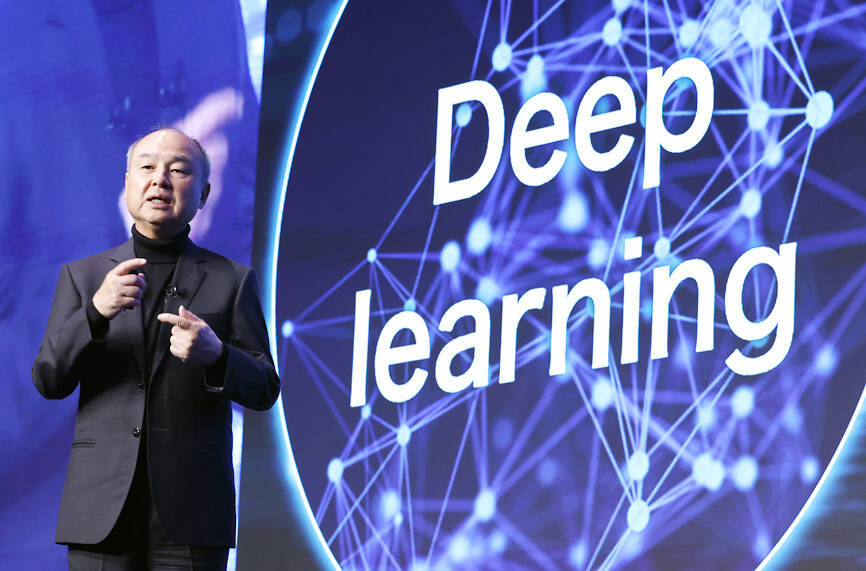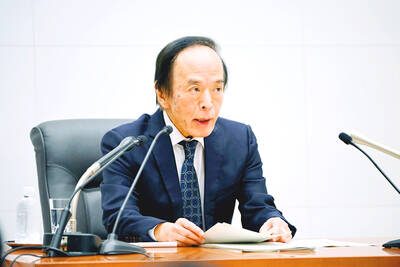Softbank Group Corp is building up stakes in Nvidia Corp and Taiwan Semiconductor Manufacturing Co (TSMC, 台積電), the latest reflection of founder Masayoshi Son’s focus on the tools and hardware underpinning artificial intelligence (AI).
The Japanese technology investor raised its stake in Nvidia to about US$3 billion by the end of March, up from US$1 billion in the prior quarter, regulatory filings showed. It bought about US$330 million worth of TSMC shares and US$170 million in Oracle Corp, they showed.
Softbank’s signature Vision Fund has also monetized almost US$2 billion of public and private assets in the first half of this year, a person familiar with the fund’s activities said.

Photo: EPA
The Vision Fund prioritizes its returns on investment, and there is no particular pressure from Softbank to monetize its assets, said the person, who asked not to be named discussing private information. A representative of Softbank declined to comment.
At the heart of Softbank’s AI ambitions is chip designer Arm Holdings PLC. Son is gradually building a portfolio around the Cambridge, UK-based company with key industry players, seeking to catch up after largely missing a historic rally that has made Nvidia into a US$4 trillion behemoth and boosted its contract chipmaker TSMC near a US$1 trillion value.
“Nvidia is the picks and shovels for the gold rush of AI,” said Ben Narasin, founder and general partner of Tenacity Venture Capital.
Softbank’s purchase of the US company’s stock may buy more influence and access to Nvidia’s most sought-after chips, he said.
“Maybe he gets to skip the line,” he added.
Softbank should have benefited from that bet on Nvidia — at least on paper. Nvidia has gained about 90 percent in market value since hitting a year’s low in early April, while TSMC has climbed more than 40 percent.
Softbank’s market capitalization stands at about US$118 billion, a fraction of Nvidia’s US$4.4 trillion valuation and that of other tech companies most closely associated with AI progress.
The company parted with a 4.9 percent stake in Nvidia in early 2019 that would be worth more than US$200 billion today. The company’s attempts to buy back some Nvidia shares, alongside those of proxy TSMC, would help Son regain access to some of the most lucrative parts of the semiconductor supply chain.
The 67-year-old Softbank founder now seeks to play a more central role in the spread of AI through sweeping partnerships. These include the company’s US$500 billion Stargate data center foray with OpenAI, Oracle and Abu Dhabi-backed investment fund MGX. Son is also courting TSMC and others about taking part in a US$1 trillion AI manufacturing hub in Arizona.
As Arm’s intellectual property is used to power the majority of mobile chips and is increasingly used in server chips, Softbank could carve out a unique position without being a manufacturer itself, said Richard Kaye, co-head of Japan equity strategy at Comgest Asset Management Ltd and a long-time Softbank investor.
“I think he sees himself as the natural provider of AI semiconductor technology,” he said. “What Son really wants to do is capture the upstream and the downstream of everything.”

Taiwan Semiconductor Manufacturing Co (TSMC, 台積電) last week recorded an increase in the number of shareholders to the highest in almost eight months, despite its share price falling 3.38 percent from the previous week, Taiwan Stock Exchange data released on Saturday showed. As of Friday, TSMC had 1.88 million shareholders, the most since the week of April 25 and an increase of 31,870 from the previous week, the data showed. The number of shareholders jumped despite a drop of NT$50 (US$1.59), or 3.38 percent, in TSMC’s share price from a week earlier to NT$1,430, as investors took profits from their earlier gains

In a high-security Shenzhen laboratory, Chinese scientists have built what Washington has spent years trying to prevent: a prototype of a machine capable of producing the cutting-edge semiconductor chips that power artificial intelligence (AI), smartphones and weapons central to Western military dominance, Reuters has learned. Completed early this year and undergoing testing, the prototype fills nearly an entire factory floor. It was built by a team of former engineers from Dutch semiconductor giant ASML who reverse-engineered the company’s extreme ultraviolet lithography (EUV) machines, according to two people with knowledge of the project. EUV machines sit at the heart of a technological Cold

TAIWAN VALUE CHAIN: Foxtron is to fully own Luxgen following the transaction and it plans to launch a new electric model, the Foxtron Bria, in Taiwan next year Yulon Motor Co (裕隆汽車) yesterday said that its board of directors approved the disposal of its electric vehicle (EV) unit, Luxgen Motor Co (納智捷汽車), to Foxtron Vehicle Technologies Co (鴻華先進) for NT$787.6 million (US$24.98 million). Foxtron, a half-half joint venture between Yulon affiliate Hua-Chuang Automobile Information Technical Center Co (華創車電) and Hon Hai Precision Industry Co (鴻海精密), expects to wrap up the deal in the first quarter of next year. Foxtron would fully own Luxgen following the transaction, including five car distributing companies, outlets and all employees. The deal is subject to the approval of the Fair Trade Commission, Foxtron said. “Foxtron will be

INFLATION CONSIDERATION: The BOJ governor said that it would ‘keep making appropriate decisions’ and would adjust depending on the economy and prices The Bank of Japan (BOJ) yesterday raised its benchmark interest rate to the highest in 30 years and said more increases are in the pipeline if conditions allow, in a sign of growing conviction that it can attain the stable inflation target it has pursued for more than a decade. Bank of Japan Governor Kazuo Ueda’s policy board increased the rate by 0.2 percentage points to 0.75 percent, in a unanimous decision, the bank said in a statement. The central bank cited the rising likelihood of its economic outlook being realized. The rate change was expected by all 50 economists surveyed by Bloomberg. The